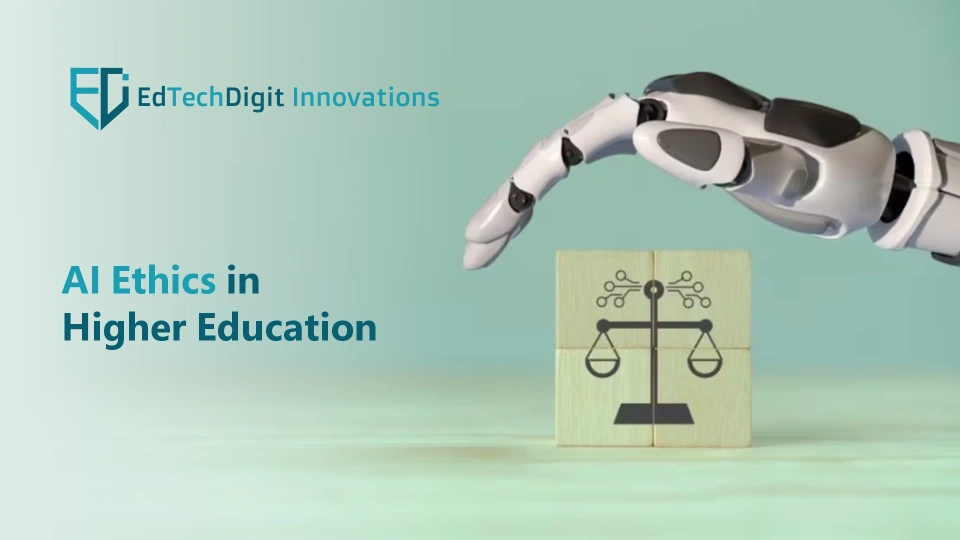AI is no longer a futuristic element for higher education—it already permeates academic, research, and administrative systems. Higher education is now responsible for deploying AI ethically as they embrace it at scale.
AIPRM has identified that global spending in the AI-in-education market grew from around $2.5 billion in 2022 to a projected $6 billion by 2025, while more than half (53%) of higher-education students use AI to create content that impacts their grades. Higher education students are now in a position to lead discussions about ethical frameworks and digital responsibility because of the wealth of human resources, interrelatedness of disciplines, and extensive way the AI approach works.
This blog will illustrate how higher education institutions take responsibility for the ethical future of AI, caution, context, and care over their campuses.
Academia’s Advantage in Ethical Technology Leadership
Universities, schools are uniquely placed to consider the ethics and philosophy around using AI because of their interdisciplinary nature. Many are already using AI in some way in their curriculum and course delivery and are making sure students understand not only how to use the tools but also the ethical contexts in which they work. The educational environment creates dialogue from a technical, legal, philosophical, and social perspective, all the things needed to develop ethics for the future.
Unpacking the Moral Dilemmas of Campus AI
As AI continues to grow, universities are studying several ethical options that go beyond simple policy and will influence behavior in future users and innovators.
Balancing Access and Opportunity
There is a variety of proficiency and confidence when students use AI tools. Students with better reasoning skills will take more from these tools, and, in turn, the knowledge gap continues to grow. Universities need to consider how they can level that gap by teaching critical digital skills as essential learning in today's student experience.
Managing Misinformation and Misuse
AI programs can produce reasonable but factually incorrect outputs. It raises alarm bells when students uncritically rely on these outputs for classwork or research. Higher education institutions have to make sure that students can acquire critical evaluation skills to prevent mindless dependence on algorithm-provided results.
Safeguarding Data in Academic Environments
Privacy is also a major issue. Students and faculty may enter personal or research data into AI applications, not fully realizing the implications of doing so. Given that schools manage voluminous amounts of sensitive data, they have a greater responsibility to protect confidentiality in all data use and establish limits on usage in their policies.
Addressing Built-In Biases
AI learns from societal data and thus inherently replicates prior stereotypes. In imagery or text generation, uncontrolled outputs from AI have the potential to codify the biases and privileges we already have in society. Academic leaders much thoughtfully examine and rectify the biases because custodianship of an institution implies protection of the community over time.
Redefining Integrity in the AI Age
With AI being able to produce essays and solve problems, institutions will face issues of academic dishonesty. Sets of distinctions need to be made as to proper use and inappropriate shortcuts and possible breaches of ethics. Developing sets of guidelines aligns with new sets of standards and values.
Where Human Judgment Still Reigns Supreme
Even with impressive abilities to crunch data, AI needs attention to its role in decision-making in certain critical areas. Factors surrounding mental health, academic advising, and grading each rely on context, nuance, and empathy, things machines cannot yet mimic. AI may be helpful in background analytics or summarization, but we must leave the final decision to trained professionals in the fields.
Likewise, in administrative contexts, schools need to maintain monitoring and control of human resources to manage financial aid applications or payroll procedures to guard against impartiality or even error in accuracy. AI can certainly be a useful co-pilot, but should not be trusted to fly on autopilot with our human beings or important decisions.
Empowering Ethical Oversight Through Campus Tech Leadership
School information technology departments are much more than technical facilitators; they are the stewards of ethical standards for AI. IT departments facilitate conversations on campuses, provide training opportunities, and make recommendations about what tools are approved for adoption.
Each institution is creating its own AI tools using its own data. This helps reduce certain types of bias in the content and ensures the AI reflects the institution’s values and standards. IT leaders also check the risks involved in using these tools and their updates. They decide whether to test new AI tools or not, while also considering if the institution is technically and ethically ready.
IT departments can take advantage of partnerships with the academic workforce - faculty, researchers, and technologists in order to include ethical checkpoints through all stages of adopting AI to help ensure that the technology is in service of the mission of higher education.
Conclusion
Though it is already happening somewhat in tangential conversations and practice, higher education institutions are leading the way to responsibly and ethically integrate AI. Schools are facilitating serious opportunities for deep and academic engagements to identify their models for using AI in a purposefully considerate way with appropriate oversight and analysis.
In addition to preparing students to find their place in an AI-influenced world, they will be able to model the framework through which society will decide its measures for AI. Through purposeful collaboration and values-based engagement, HEIs are paving the way to the future of ethical engagement and innovation.

